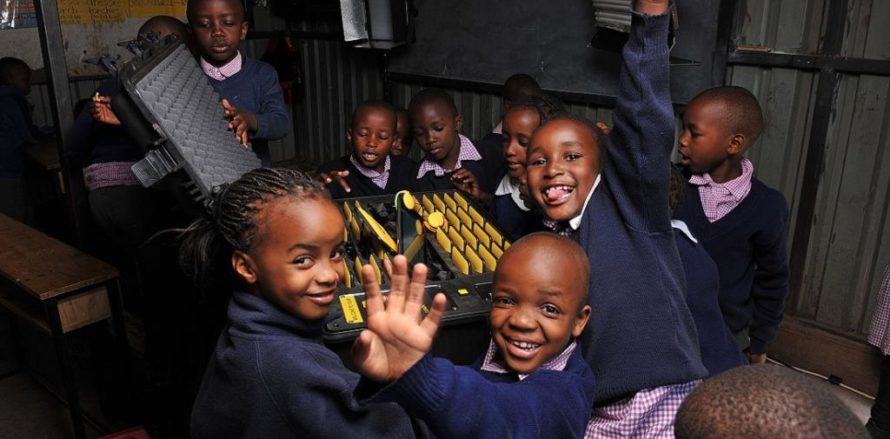In July, the UK and Kenya will co-host a summit in London on behalf of the Global Partnership for Education, which supports access to schooling in lower-income countries. The $5 billion that both countries hope to raise will go in large part toward innovative learning solutions for socially and economically vulnerable children. According to Kenya’s President Uhuru Kenyatta, funding from GPE is a chance “to invest in quality education,” so Kenyan children can receive “the skills and knowledge they need to seize the opportunities of the 21st century.” Africa is hungry for high-quality education.
Thanks to rising mobile phone availability, edtech startups have been able to introduce their digital products, redefining traditional classrooms. Tuteria and PrepClass, for example, connect learners with tutors, while M-Shule delivers educational content through SMS and chatbots, and Ambani uses AR to teach young people African languages. The edtech market’s variety accommodates diverse approaches to learning, whether students prefer interactive lessons with a tutor, or self-motivated study more like exam prep. According to venture capital firm Partech Partners, from 2015 through 2020, the number of African tech startups with financial backing grew six times faster than the global average.
The post-pandemic year is no exception. In June, Ed Partners Africa, a financing company for affordable private schools, raised $1.9 million. Computer science education platform HyperionDev, based in Cape Town, received $3.5 million. Finally, ULesson, an edtech startup offering several core subjects and practice questions for state exams , raised $7.5 million. When Andrey Lebedev, LP at New York-based 13Ventures and co-founder of Digital Disrupt investment club, began to consider investing in edtech in Africa, he came equipped with experience in developing products for emerging markets. “In Russia, we’ve been launching apps to help kids memorize what they’ve just learned at school through gamification,” Lebedev said. “We’ve been focusing on helping teachers through entertainment instead of offering kids additional courses.”
For this purpose, Lebedev established K-Platform, based in Moscow. Entering the African market was his next step, and Kenya became his launchpad for the rest of the continent. One of the most technologically advanced regions in Africa, Kenya is also known as the Silicon Savannah. According to a Digital 2021 report from DataReportal, the country’s mobile penetration rate is almost 109 percent, with some people using more than one SIM card. At the same time, there are only about 21.75 million Internet users in Kenya. With an Internet penetration rate of just 40 percent, a major market remains untapped, one that techpreneurs from around the world now have their eyes set on. During COVID-19, the mobile penetration rate grew 11 percent between January 2020 and January 2021, reaching a total of 59.24 million connections. “Most children in Kenya have cell phones,” Lebedev said. “Although these are older Android models, we’ve been able to help teachers working in crowded classrooms.”
The teacher-to-student ratio in Kenyan public schools is 1:50. Only about 25 percent of schools in Kenya are private, most supported by businesses and nonprofits, with an average teacher-to-student ratio of 1:20, depending on the school fees. With Kenyan business partners, Lebedev offered his digital solutions to Kenyan teachers. “We created apps in cooperation with the local schools based on their curriculums,” Lebedev said. “The most popular subjects in Kenya are English, Math, Environmental Activities and Christian Religious Activities, so we’ve decided to focus on them.” Despite knowledge of the Kenyan market and assistance from his local partner, Lebedev had a lot to learn. “When we first launched in Africa, our apps were integrated with Google Pay,” said Lebedev.
“It turned out Google Pay is only available as an online payment option when integrated with M-PESA, Kenya’s mobile money transfer service.” Users currently pay $1 every three months for Lebedev’s app. “Prices in Africa are low compared to the U.S. and Europe, and one dollar is a significant expense for Kenyan citizens,” Lebedev explained. Nearly half of Kenyan households earn less than $93 per month. “Marketing, in particular social media channels and user acquisition, is also significantly cheaper in Africa. We pay around 14-20 cents for every thousand users.” In many countries during the pandemic, online learning replaced the physical classroom, but education officials in Kenya decided to cancel the academic year.
The majority of students in poor and rural areas couldn’t follow online learning programs due to limited Internet access, or even electricity shortages. Kenyan schools recently reopened after a long interruption, from March 2020 — January 2021, and many students had to repeat a year. “Technology could help teachers bridge the learning gap,” Lebedev believes. “Africa has the potential to become the new China for global investors. And a huge demand for high quality interactive education will drive the rise of edtech solutions, bringing new investment opportunities.” COVID-19 disrupted education for about 18 million children in Kenya, and highlighted gender inequalities. Only 84 percent of Kenyan girls have re-enrolled in local schools after the lockdown, compared to 92 percent of boys.
Recent Posts
- List of Top 10 Teacher Training Conferences in 2025 in London UK Europe US, Germany, France, Asia, China, Saudi, UAE, India and Japan
- Top 10 AI Tools for A-Level Exams Questions in UK, Europe, India, Pakistan, South Africa, Germany, USA, Malaysia and Canada
- List of Top 10 AI in Education Startups in London, UK, Europe, USA, Asia, India, China, Japan, Saudi, UAE and Germany
- Top 10 Education Conferences in 2025 in London, UK, Europe, USA, UAE, Canada, and China
- Humanoid Robots in Education: Transforming the Learning Landscape in UK, Europe, India, China and UAE in 2025
